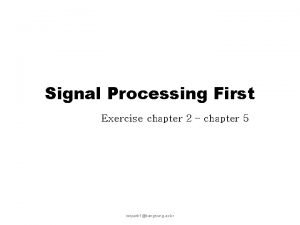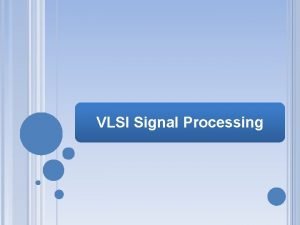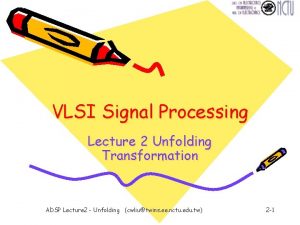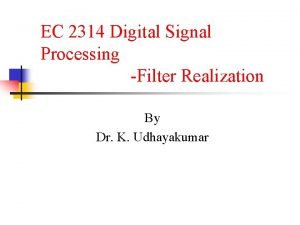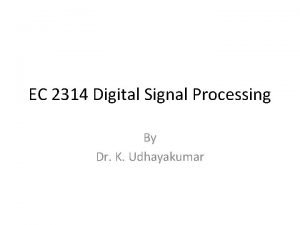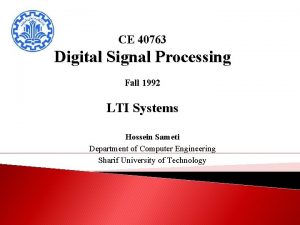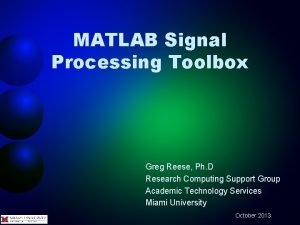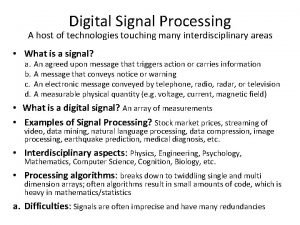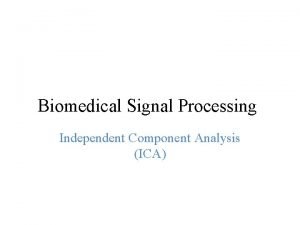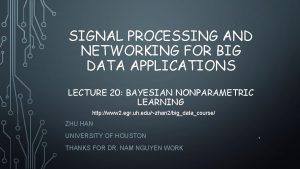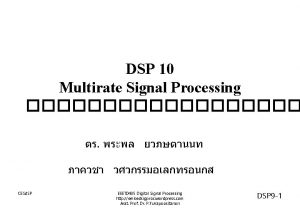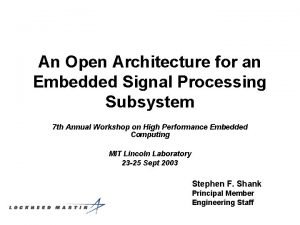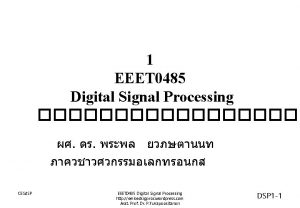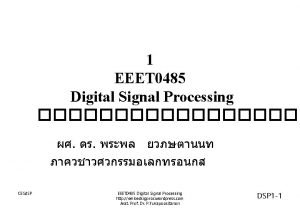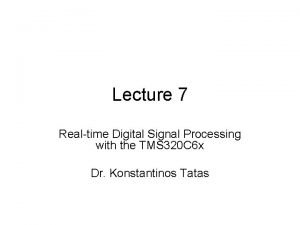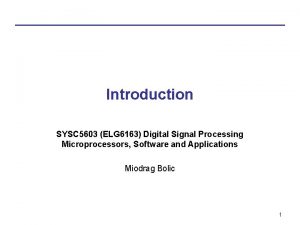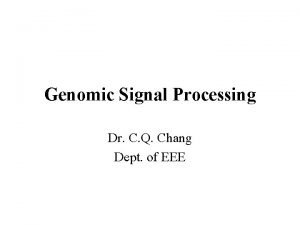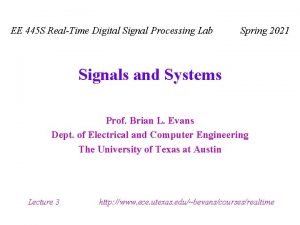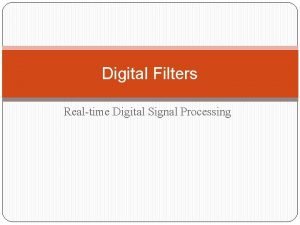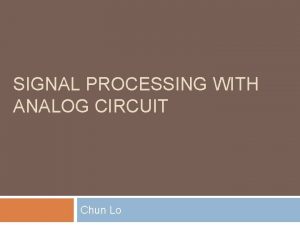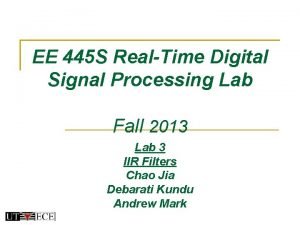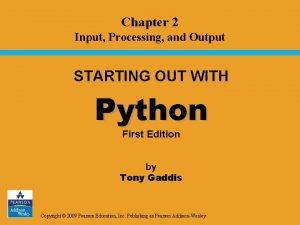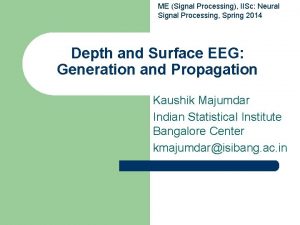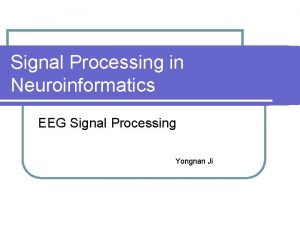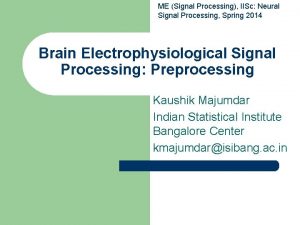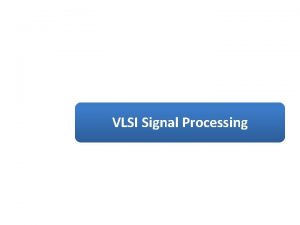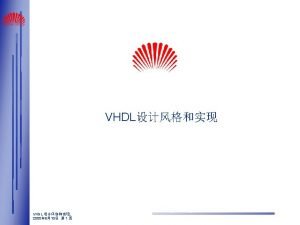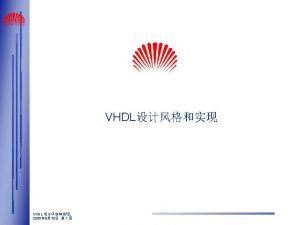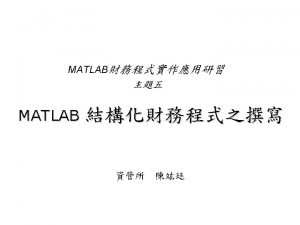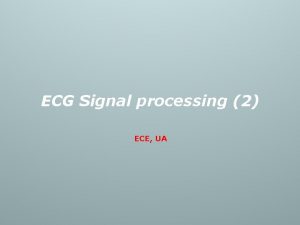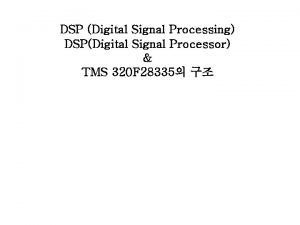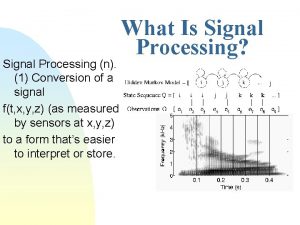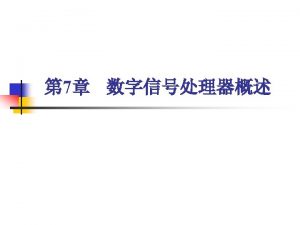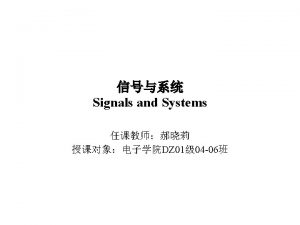Chapter 12 Signal processing Signal processing refers to















































- Slides: 47


Chapter 12 Signal processing

• Signal processing refers to analog and/or digital manipulation of signal • Image processing is a form of signal processing in which the manipulations are performed on digitized image • Aliasing may happens when analog signal is digitized and again the digitized signal converted to analog

Sequences of events in SE

Time requirements • Frequency encoding step takes about 10 ms(4 -8 ms for high field and 1630 ms in low field) • Phase encoding step takes 1 -5 ms • Each RF pulse (with a Gz gradient) takes 2 -10 ms • Time spend from center of 90 degree pulse to the end echo readout is: • TE+1/2 sampling time)=TE+1/2 Ts • Active time=TE+1/2 Ts+To • Time spend to obtain one slice image =Ny(number of phase encoding)x. TR

• The center of the k-space always contain the weakest phase encoding gradient and hence most signal • The periphery of k-space contain highest phase encoding gradient and hence weakest signal

• Time spend to obtain one slice image =Ny(number of phase encoding)x. TR

Multi slice technique

Max NO of Slices(coverage)=TR/(Active time) or. TR/(TE+1/2 Ts+to) • Each slice has its own k-space

Aliasing • when analog signal is digitized and again the digitized signal converted to analog may happen • Undersampling Alising

Sampling Theorem (Nyquist law) • If ωmax is the maximum frequency in the signal, the sampling rate must be at least twice the maximum frequency to avoid aliasing. ωsampling=1/ΔTs≥ 2ωmax Ts=Nx. ΔTs=256 x ΔTs In a composite signal minimum sampling should be at least two times the maximum frequency present in the sample


• In MRI imaging; to reduce sampling time; minimum possible sampling of the signal is performed therefore: Bandwidth(BW)=2(ωmax)=1/ΔTs ΔTs=Ts/Nx=8 ms/256=0. 0000137 BW=1/ ΔTs=1/0. 0000137=32 k. Hz=± 16 k. Hz • In MRI k space is the digitized version of received signal • A minimum of two samples/cycle is taken and is put in data space

Signal to Noise ratio (SNR)

Chapter 13 Data space

Where dose k-space come from • K-space derived from data space • It is a digitized version of data space • The x axis is spatial frequency • It has 256 phase encoding steps on y axis (+127 to -127) and 256 frequency on x-axis • Each line in the data space contain signal from entire slice • In the center row and column we put the signal with no phase encoding gradient (in x and y direction) hence max signal

• The time taken to go from one row to another is TR • The time taken to go from one point in a row to another is ΔTs • The time taken to fill one row of data space is: • Ts =(ΔTs )(Nx)=(50 ms)(256)=8. 12 ms • The time taken to fill one column of data space is Nyx. TR (for TR=500 ms and Ny=256); it is about 2 min

Motion artifact • The time to fill one row is about 8 ms • The time to fill one column is about 2 min • The motion artifact is mainly in y direction or in phase encoding direction

Properties of K space • 1 -The center of data space contains maximum signal • 2 -The maximum amplitude occurs in the center row • 3 -In y direction because of phase encoding gradient • 4 -In x direction because of rephasing and dephasing

Image of k space • The k space appear as a series of concentric rings of signal intensities oscillating from max to min • The intensities on the center is max and decrease when goes to periphery

Edge of k space • The detail information provides by periphery data • The is no absolute relation between center data and center of the image

K space symmetry • Image can be constructed from ½ (1/2 NEX) and ¼ (1/4 NEX) of the data

Chapter 14 Pulse sequence diagram

Pulse sequence diagram (PSD) • PSD of SE • After Gz to refocus the spins a negative pulse is applied • Crusher gradients are applied at each sides of 180 pulse to achieve more accurate refocusing at time TE

• When apply Gx when we are reading the echo, we end up dephasing everything • To get a good signal during Gx, a negative gradient with area equal to ½ Gx is applied before Gx

• Pre Gx gradient can be positive if it comes before 180 focussing pulse • In this case spins defase in positive direction but with 180 degree pulse they reverse

Chapter 15 Field of View (FOV)

• FOV: desired part of the body under investigation. • FOV depends on: • 1 -BW • 2 -Gradients

FOV • • • • FOV is selected by operator FOV depends on BW and Gradients. In x direction: Bx=(Gx). x γ. Bx= γ. (Gx). x fx=γ. (Gx)x fmax=γ. (Gx)FOV/2 -fmax=-γ. (Gx)FOV/2 +fmax to fmax=2 fmax=BW BW=γ. (Gx)FOV FOVx=BW/γ. Gx To FOV BW Gradient

What is the min possible FOV: • FOVmin=BWmin/ γ Gmax • BWmin and Gmax are machin dependent. For Echospeed Plus 1. 5 T scanner: • Gmax=23 m. T/m • BWmin=± 4 k. Hz=8 k. Hz • Therefore FOVmin=0. 8 cm

Chapter 16 K space Final Frontier

• What is the dimensions of the kspace matrix • The data matrix of the image is very asymmetric • Its y direction is taken in Ny. TR which is about several min • Its x direction is about 8 ms

• • • We had FOVx=BW/γ. Gx We know that BW=1/ΔTs Therefore FOVx=BW/γ. Gx=1/ γ. Gx ΔTs Or : 1/FOVx= γ. Gx ΔTs Term γ. Gx ΔTs is denoted Δkx hence • Δkx =γ(MHz/Tesla). Gx(mili. Tesla/m). ΔTs (ms) • Δkx (cycle/m)=1/FOV

• Main thing is: • • Δkx(cycle/m)=1/FOV Δx=pixel size in image Δk=pixel size in k space X=FOVx=sum of the pixels in image • K=sume of the pixels in kspace • K space is the spatial frequency domain • In Y direction the same is true (ky=1/ Δy) or Δky=1/FOVy

• The relation between phase and frequency is: • Θ=∫ωdt • ω=γ. B= γ. G. x • Θy= ωy. ty= γ. By. ty= γ. Gy. y. ty= (γ. Gy. ty)y=ky. y

Chapter 17 Scan parameters and Optimization

Scan parameters • • • • Primary parameters (are set directly) and are: A) contribute to image contrast: TR TE TI FA (flip angle) B) Contribute to coverage Slice thickness Interslice gap C) Contribute to resolution FOV (in x and y direction) Nx Ny NEX Bandwidth

Scan parameters From the primary parameters we can get secondary parameters which are: 1) S/N 2) Resolution 3) Coverage 5) Scan time 6) Image contrast

• • • SNR (signal to noise ratio) SNRα (voxel volume) {(Ny)(NEX)/BW}1/2 NEX (number of excitation) NEX => SNR by (NEX)1/2 BW => SNR BW=N (number of pixel in x direction)/Ts (read out or sampling time) example 256/8=32 KHz • (S 1+S 2)/(N 1+N 2)=2 S/(2)1/2 N=(2)1/2 S/N

SNR increase by doing the following: • • 1)increasing TR 2)Decreasing TE 3)Using lower BW (by BW-1/2) 4)Using volume imaging 5)Increasing NEX (by NEX 1/2) 6)Increasing Ny (by Ny 1/2) 7)Increasing voxel size

SNR in 3 D • SNRα (voxel volume) {(Nz)(Ny)(NEX)/BW}1/2 • SNR(in 3 D) α (Nz)1/2 SNR(in 2 D) • 1/BW=Ts/Nx=> • SNRα (voxel volume) {(Ny)(NEX)(Ts)/Nx}1/2 • T=Ts. Ny. NEX=> • SNR α(voxel volume)(total sampling time of all the signals) 1/2

• • • Resolution It is determined by : 1 -Pixel size=FOV/No. of pixels Ny =>better Res. 2 -Total sampling time • Acquisition time • Scan time=TR. Ny. NEX • FSE time=TR. Ny. NEX/ETL • In 3 D: • Time=TR. Ny. Nz. NEX

Coverage (distance covered by multislice acquisition) • • • • 1) Increase if: >>Increase slice thickness >>increase interslice gap >>Increase TR or decrease the last TE (i. e. Increase TR/TE) >>Decrease sampling time Ts (resulting in lower TE) 2) Coverage increase if: >>Increase TE >>Increase Ts >>Increase ETL in FSE imaging (due to longer final TE) 3)Increase interslice gap causes: >>Increase coverage >>Decrease cross-talk artifact >>Increase SNR (due to increasing effective TR by reducing cross-talk) • >>Decrease detection of small lesions (which may lies within the gap)

What happens if we increase or decrease TR • • • 1) Increasing TR: Increase SNR (according to T 1 recovery curve) Increase coverage (more slice) Decrease T 1 W image Increase PD and T 2 weighting Increase scan time 2)Decreasing TR: Decrease SNR Decrease coverage Increase T 1 W Decrease PD and T 2 weighting

What happens if we change TE • 1) Increasing TE: • Increase T 2 W • Increase dephasing and thus decrease SNR (according to t 2 decay curve) • Decrease number of possible slice (decrease coverage) • No change in scan time • 2)Decreasing TE: • Decrease T 2 W or PDW • Increase SNR (less dephasing) • Increase coverage • No change in scan time

TI (inversion time) • Advantages: • Can suppress various tissue by selecting appropriate TI • 1 -STIR when TI=0. 693 T 1(fat) • 2 -FLAIR when TI=0. 693 T 1(fluid) • Disadvantages: • 1 -Decrease SNR • 2 -Decrease coverage (by a factor of about 2 due to presence of the extra 180 degree pulse)

 Baseband signal and bandpass signal
Baseband signal and bandpass signal Baseband signal and bandpass signal
Baseband signal and bandpass signal Digital signal as a composite analog signal
Digital signal as a composite analog signal What is the product of an even signal and odd signal
What is the product of an even signal and odd signal Signal processing first
Signal processing first Vl
Vl Unfolding in vlsi signal processing
Unfolding in vlsi signal processing Digital signal processing
Digital signal processing Types of signals
Types of signals Dr sujan ali
Dr sujan ali Digital signal processing
Digital signal processing Signal processing toolbox matlab
Signal processing toolbox matlab Digital signal processing
Digital signal processing Pca vs ica
Pca vs ica Signal processing for big data
Signal processing for big data Financial signal processing
Financial signal processing Digital signal processing
Digital signal processing Digital signal processing
Digital signal processing Embedded signal processing solutions
Embedded signal processing solutions Digital signal processing
Digital signal processing Digital signal processing
Digital signal processing Dsp
Dsp Asic form 5603
Asic form 5603 Genomic signal processing
Genomic signal processing What is digital signal processing
What is digital signal processing Time reversal z transform
Time reversal z transform Signal processing filter
Signal processing filter Signal processing solutions
Signal processing solutions High-performance digital signal processing
High-performance digital signal processing Precision analog signal processing
Precision analog signal processing Digital signal processing
Digital signal processing Bottom up and top down processing
Bottom up and top down processing Gloria suarez
Gloria suarez Bottom up processing
Bottom up processing Point processing operations
Point processing operations Primary processing vs secondary processing
Primary processing vs secondary processing Define point processing
Define point processing Histogram processing in digital image processing
Histogram processing in digital image processing Parallel processing vs concurrent processing
Parallel processing vs concurrent processing A generalization of unsharp masking is
A generalization of unsharp masking is What is point processing in digital image processing
What is point processing in digital image processing Morphological processing in digital image processing
Morphological processing in digital image processing Bottom up processing
Bottom up processing Interactive processing
Interactive processing Chapter 2 input processing and output
Chapter 2 input processing and output The term diversity refers to
The term diversity refers to Corporate culture refers to
Corporate culture refers to Working capital management refers to
Working capital management refers to




